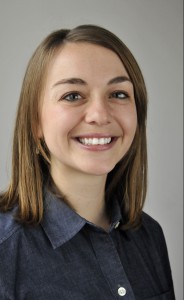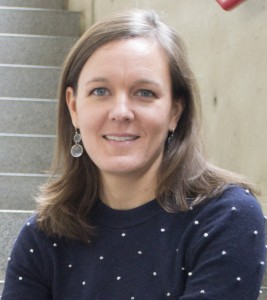Chris Johnson | The Fuller Center for Housing
Helping the residents of the historic Baptist Town neighborhood been a passion for Emily Roush-Elliott since she arrived in Greenwood on an Enterprise Rose Architectural Fellowship in 2013 after receiving her master’s of architecture from the University of Cincinnati.
Roush-Elliot
Helping families in need have simple, decent homes has been a passion for the Greenwood/Leflore Fuller Center for Housing since 1985, when it began partnering with homeowner families as a Habitat for Humanity affiliate. (They joined The Fuller Center in 2008.)
Their common interests are why Roush-Elliott — who is hosted by the Greenwood-LeFlore Economic Development Foundation and Carl Small Town Center — and The Fuller Center have been frequent collaborators in the past few years. And they continue to lead efforts to improve the Baptist Town neighborhood, made famous as the home of blues legend Robert Johnson and the site of filming for the film “The Help,” which brought home the Best Picture Oscar in 2012.
One initiative that has had tremendous impact was the installation of 11 unused MEMA (Mississippi Emergency Management Agency) cottages that were designed for families impacted by Hurricane Katrina. With strong support from the city of Greenwood and approval by the Mississippi legislature, the cottages were turned over to The Greenwood/Leflore Fuller Center, which installed the cottages with a few tweaks and turned them into beautiful, cozy homes for families in need.
“All 11 cottages are fully occupied, and I don’t think we’ve had a single person miss a single payment since we had people move in over a year ago,” Roush-Elliott said. “We’re just looking to have it grow and do more.”
Doing more included using grant money from Enterprise Community Partners to institute such projects in the neighborhood as a storm water management garden, which they also have used to provide on-the-job training for some unemployed women in the community.
Another area of focus in helping residents is energy efficiency. With the help of Emily McGlohn, assistant professor of architecture at Mississippi State University, and her “Audit Squad” of students, they have identified ways in which residents of the Baptist Town neighborhood can save significant amounts of energy — and money — by taking seemingly small steps to make a tremendous difference.
The energy-efficiency study
The Baptist Town community became a significant focal point of McGlohn’s wide-ranging concern for energy-efficiency issues throughout the Mississippi Delta region. This historic neighborhood of Greenwood provided the perfect testing ground with its mix of old homes, newer Fuller Center construction and the Katrina cottages.
“You can always assume new housing is better than old housing, but until you put numbers to it, it’s not as powerful,” McGlohn said. “That’s what we wanted — to be able to quantify the difference and put it into dollars to help people understand how important energy efficiency is in affordable housing.”
McGlohn
Using an array of tools — most notably powerful blower doors and thermal imaging cameras — they studied the 11 cottages’ performance compared to 10 older homes and six Fuller Center homes.
“We had our hypothesis that the cottages would be the most airtight, The Fuller Center homes would be in the middle and the neighborhood homes would be the least,” Roush-Elliott said. “Our hypothesis was certainly proved true, but it was so much more extreme than expected. We were blown away by the unequal distribution of energy costs. It’s a real inequity that we can address.”
“Some of them, we couldn’t even get a read on,” McGlohn said of the older homes in the neighborhood. “They were so leaky that the machine couldn’t even pressurize them.”
They used the test results to determine the personal financial impact of air infiltration alone in trying to maintain a modest home temperature of 65 degrees in December — on top of other factors in heating or cooling a home. They found that air filtration alone cost an average of:
- $176 a month for the 10 older homes tested, or 14% of a minimum wage earner’s monthly income
- $88 a month for the 6 Fuller Center homes, or 7% of a minimum wage earner’s monthly income
- $35 a month for the 11 Katrina cottages, or 3% of a minimum wage earner’s monthly income
“That’s money in your pocket,” McGlohn said. “Housing should be efficient for everyone but especially for those in low-income housing. But it’s not just housing in this sector — we can all do little things to save energy.”
The study’s results, though, are just a starting point.
“It’s great to just swoop in with this information and say, ‘Yeah, your house is leaky,’ but what do you do with that information?” McGlohn asked rhetorically. “The little things that you do really add up in these situations. The solution isn’t always to knock down your house and build a better one. You can fill air gaps and weatherize the house. So we provided weatherization kits for all the homeowners.”
“Emily was able to come back and make recommendations to The Fuller Center about really simple things that they can do throughout the construction process that will save their homeowners more money on the back end on their energy bills,” Roush-Elliott said. “We had a little bit of grant money left so that we could buy a small energy upgrade kit, a little retrofit kit, for everybody who participated. It’s very simple things like caulk and weatherstripping.”
The biggest culprit for the older homes in the neighborhood was window air-conditioning units, something McGlohn said is not unusual for any home with window units.
“We assume that even though homeowners are supposed to take them out in the wintertime, they don’t,” she said. “Those units become like a big hole in the wall, and I’m not sure everybody understands what the effect of that is.”
Roush-Elliott said that her agency is working with The Fuller Center and others to distribute and install covers for the window units in the older homes. She also said that the weatherization study has caught the eye of state officials, who will come to Baptist Town in the near future to discuss major weatherization grants with local residents.
“I’m amazed how many people at the state level have taken note even though this is really small, so I’m hoping that this might grow into something a lot more,” she said, adding that there are plans to follow-up on the weatherization efforts to determine how much they might be saving residents on their energy bills.
Greenwood/Leflore Fuller Center President Rocky Powers praised the work of both Roush-Elliott and McGlohn and said that their research will help as they partner with both existing and future Fuller Center homeowners, in addition to helping facilitate ongoing weatherization efforts for the older homes in the neighborhood.
HUD report on the Baptist Town project.

